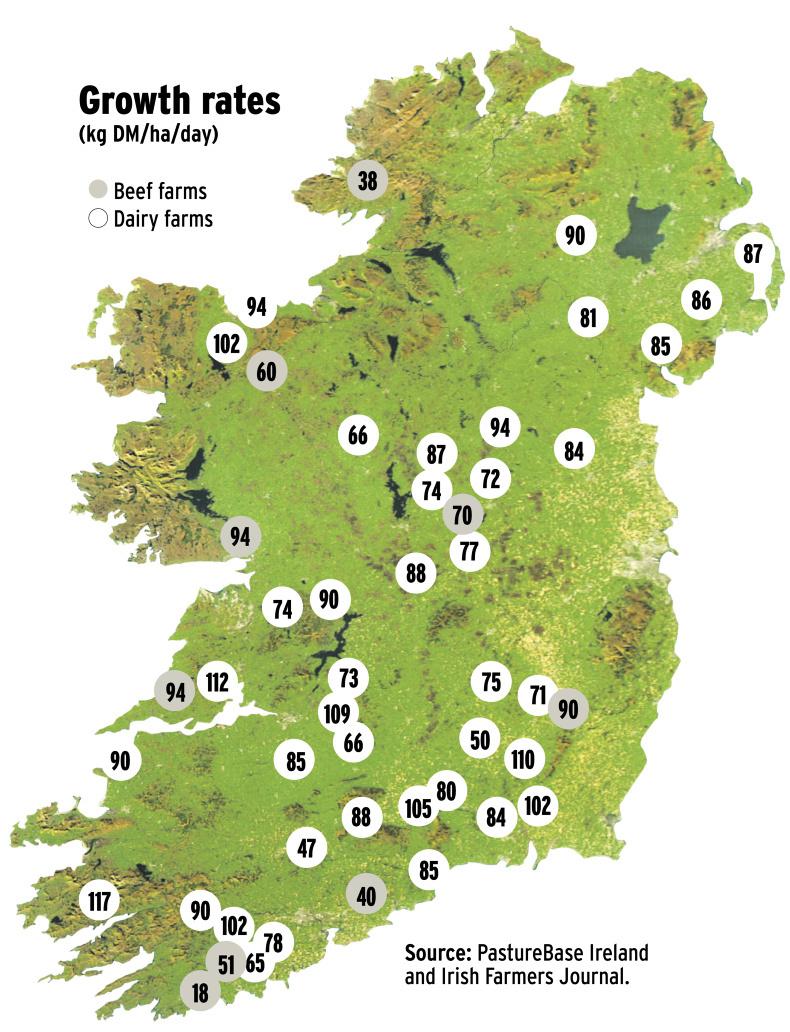The national average growth rate on drystock farms is 20kg DM/ha/day. That’s a pretty insignificant growth rate – which is of course to be expected – but it’s not going to worry most farmers who now have the majority of cattle housed at this stage.
What the small volume of growth will do, however, is continue to develop covers on field that were closed in early October. Provided you have resisted the temptation to go back in and graze, there should be nice picking on the farm come February and March – if the weather plays ball.

Average farm cover is the only grass figure that really matters now. Target closing cover should be between 500kg and 550kg DM/ha.
Try hard to get down to this target – carrying too much grass into the winter will result in dry matter losses and it will lead to poor grass quality and poor regrowths next spring.
Remember the difference between your current farm cover and the target farm cover is what you have left to graze. Divide your demand into this figure to find out how long it will take you to graze it. If you have too much grass, you need to keep demand high. This means keeping out as many cattle as you can manage.

If you are going to run out of grass too quickly, you need to reduce demand. This can be done via housing stock or by supplementing cattle at grass.
Supplementing cattle at grass gets difficult at this time of year with damage being done around feeding troughs. If housing, try to house cattle on a dry day and avoid doing much with them like dosing or clipping for a few days until they are settled.
If ewes continue to graze off grass, make sure they are confined to specific fields and they dont get access to the whole farm. Grazing off grass already closed will have a negative affect on early turnout next spring.
Just because grazing is winding up for the year, doesn’t mean measuring should stop. If you haven’t already done so, complete a fodder budget and get your silage tested as soon as possible. With winter coming one month early in some cases, fodder reserves might run tighter than you initially forecast.
The national average growth rate on drystock farms is 20kg DM/ha/day. That’s a pretty insignificant growth rate – which is of course to be expected – but it’s not going to worry most farmers who now have the majority of cattle housed at this stage.
What the small volume of growth will do, however, is continue to develop covers on field that were closed in early October. Provided you have resisted the temptation to go back in and graze, there should be nice picking on the farm come February and March – if the weather plays ball.

Average farm cover is the only grass figure that really matters now. Target closing cover should be between 500kg and 550kg DM/ha.
Try hard to get down to this target – carrying too much grass into the winter will result in dry matter losses and it will lead to poor grass quality and poor regrowths next spring.
Remember the difference between your current farm cover and the target farm cover is what you have left to graze. Divide your demand into this figure to find out how long it will take you to graze it. If you have too much grass, you need to keep demand high. This means keeping out as many cattle as you can manage.

If you are going to run out of grass too quickly, you need to reduce demand. This can be done via housing stock or by supplementing cattle at grass.
Supplementing cattle at grass gets difficult at this time of year with damage being done around feeding troughs. If housing, try to house cattle on a dry day and avoid doing much with them like dosing or clipping for a few days until they are settled.
If ewes continue to graze off grass, make sure they are confined to specific fields and they dont get access to the whole farm. Grazing off grass already closed will have a negative affect on early turnout next spring.
Just because grazing is winding up for the year, doesn’t mean measuring should stop. If you haven’t already done so, complete a fodder budget and get your silage tested as soon as possible. With winter coming one month early in some cases, fodder reserves might run tighter than you initially forecast.








 This is a subscriber-only article
This is a subscriber-only article










SHARING OPTIONS: